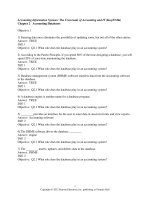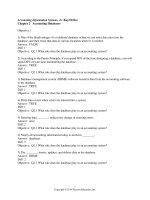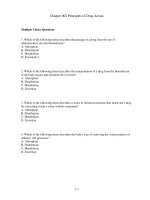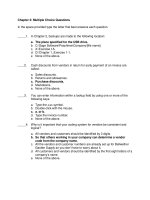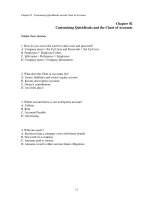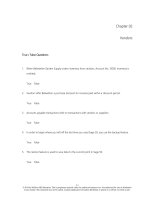Computer accounting with quickbooks 2011 13th edition donna kay test bank
Bạn đang xem bản rút gọn của tài liệu. Xem và tải ngay bản đầy đủ của tài liệu tại đây (31.76 KB, 12 trang )
Chapter 02 - Customizing QuickBooks and the Chart of Accounts
Chapter 02
Customizing QuickBooks and the Chart of Accounts
Multiple Choice Questions
1. How do you access the screen to add a user and password?
A. Company menu > Set Up Users and Passwords > Set Up Users
B. Employees > Employee Center
C. Edit menu > Preferences > Employees
D. Company menu > Company Information
2. What does the Chart of Accounts list?
A. Assets, liabilities and owner's equity account
B. Income and expense accounts
C. Owner's contributions
D. All of the above
3. Which account below is not an Expense account?
A. Utilities
B. Rent
C. Accounts Payable
D. Advertising
4. What are assets?
A. Resources that a company owns with future benefit
B. Net worth of a company
C. Amounts paid to owners
D. Amounts owed to others and are future obligations
2-1
Chapter 02 - Customizing QuickBooks and the Chart of Accounts
5. The Income Statement:
A. lists the accounts and account numbers
B. lists a company's assets
C. summarizes what a company owns and what it owes
D. reports the results of a company's operations, listing income and expenses for a period of
time
6. Which of the following is a temporary account?
A. Sales
B. Inventory
C. Accounts Payable
D. Accounts Receivable
7. An example of a non-posting account is ________.
A. Employee Expense
B. Inventory
C. Purchase Orders Account
D. Accounts Payable
8. To add a new account to the Chart of Accounts:
A. From the Chart of Accounts window, select Account, New
B. From the Company menu, select New Account
C. From the Chart of Accounts menu, select New Account
D. From the Lists menu, select New Account
9. What is the purpose of a non-posting account?
A. To calculate income.
B. To track information necessary to the accounting information system.
C. To calculate expenses.
D. To identify owner's equity.
2-2
Chapter 02 - Customizing QuickBooks and the Chart of Accounts
10. Which of the following is considered a permanent account?
A. Income Statement accounts.
B. Balance Sheet accounts.
C. All the above.
D. None of the above.
11. How may you customize QuickBooks to fit your specific needs?
A. Make changes to the Chart of Accounts.
B. Purchase one of the various QuickBooks editions.
C. Enable security access to QuickBooks files.
D. All the above.
12. Which of the following is not an income account?
A. Revenue
B. Interest Revenue
C. Rent Expense
D. Gain on sale
13. To sort the Chart of Accounts by account name:
A. Click on the Name heading bar
B. Click Account > Re-sort List
C. Click File > Sort
D. Right click Sort by Name
14. Which QuickBooks version is designed for small businesses without industry specific
needs?
A. QuickBooks Pro
B. QuickBooks Premier
C. QuickBooks Accountant
D. QuickBooks Enterprise Solutions
2-3
Chapter 02 - Customizing QuickBooks and the Chart of Accounts
15. Which QuickBooks version is designed for small businesses that have industry specific
needs?
A. QuickBooks Pro
B. QuickBooks Premier
C. QuickBooks Accountant
D. QuickBooks Enterprise Solutions
16. Which QuickBooks version is designed for mid-sized businesses?
A. QuickBooks Pro
B. QuickBooks Premier
C. QuickBooks Accountant
D. QuickBooks Enterprise Solutions
17. Balance Sheet accounts are also called:
A. equity accounts
B. temporary accounts
C. permanent accounts
D. None of the above
18. Income Statement accounts are also called:
A. equity accounts
B. temporary accounts
C. permanent accounts
D. None of the above
19. Non-posting accounts:
A. Track information required for the accounting system
B. Do not appear on the Balance Sheet
C. Do not appear on the Income Statement
D. All the above
2-4
Chapter 02 - Customizing QuickBooks and the Chart of Accounts
20. A Mortgage Payable account:
A. Has real estate as collateral
B. Is identical to a Loan Payable account
C. Is a type of Owner's Equity account
D. None of the above
21. How do you access the Statement of Cash Flows report?
A. Report Center icon > Banking
B. Report Center icon > Company & Financial
C. Report Center icon > Accountant & Taxes
D. Company menu > Company Information
22. What is an asset?
A. Mortgage payable
B. An amount a company owes
C. A resource a company owns
D. None of the above
23. What is a liability?
A. Inventory
B. An amount a company owes
C. A resource a company owns
D. None of the above
24. Which of the following increases owner's equity?
A. Dividends
B. Business losses
C. Business expenses
D. Business profits
2-5
Chapter 02 - Customizing QuickBooks and the Chart of Accounts
25. The different types of business ownership are:
A. Sole proprietorship
B. Partnership
C. Corporation
D. All the above
Short Answer Questions
26. What does the QuickBooks Company Snapshot provide?
27. Briefly explain the purpose and benefits of using a password for QuickBooks access?
2-6
Chapter 02 - Customizing QuickBooks and the Chart of Accounts
Chapter 02 Customizing QuickBooks and the Chart of Accounts Answer Key
Multiple Choice Questions
1. How do you access the screen to add a user and password?
A. Company menu > Set Up Users and Passwords > Set Up Users
B. Employees > Employee Center
C. Edit menu > Preferences > Employees
D. Company menu > Company Information
2. What does the Chart of Accounts list?
A. Assets, liabilities and owner's equity account
B. Income and expense accounts
C. Owner's contributions
D. All of the above
3. Which account below is not an Expense account?
A. Utilities
B. Rent
C. Accounts Payable
D. Advertising
4. What are assets?
A. Resources that a company owns with future benefit
B. Net worth of a company
C. Amounts paid to owners
D. Amounts owed to others and are future obligations
2-7
Chapter 02 - Customizing QuickBooks and the Chart of Accounts
5. The Income Statement:
A. lists the accounts and account numbers
B. lists a company's assets
C. summarizes what a company owns and what it owes
D. reports the results of a company's operations, listing income and expenses for a period of
time
6. Which of the following is a temporary account?
A. Sales
B. Inventory
C. Accounts Payable
D. Accounts Receivable
7. An example of a non-posting account is ________.
A. Employee Expense
B. Inventory
C. Purchase Orders Account
D. Accounts Payable
8. To add a new account to the Chart of Accounts:
A. From the Chart of Accounts window, select Account, New
B. From the Company menu, select New Account
C. From the Chart of Accounts menu, select New Account
D. From the Lists menu, select New Account
9. What is the purpose of a non-posting account?
A. To calculate income.
B. To track information necessary to the accounting information system.
C. To calculate expenses.
D. To identify owner's equity.
2-8
Chapter 02 - Customizing QuickBooks and the Chart of Accounts
10. Which of the following is considered a permanent account?
A. Income Statement accounts.
B. Balance Sheet accounts.
C. All the above.
D. None of the above.
11. How may you customize QuickBooks to fit your specific needs?
A. Make changes to the Chart of Accounts.
B. Purchase one of the various QuickBooks editions.
C. Enable security access to QuickBooks files.
D. All the above.
12. Which of the following is not an income account?
A. Revenue
B. Interest Revenue
C. Rent Expense
D. Gain on sale
13. To sort the Chart of Accounts by account name:
A. Click on the Name heading bar
B. Click Account > Re-sort List
C. Click File > Sort
D. Right click Sort by Name
14. Which QuickBooks version is designed for small businesses without industry specific
needs?
A. QuickBooks Pro
B. QuickBooks Premier
C. QuickBooks Accountant
D. QuickBooks Enterprise Solutions
2-9
Chapter 02 - Customizing QuickBooks and the Chart of Accounts
15. Which QuickBooks version is designed for small businesses that have industry specific
needs?
A. QuickBooks Pro
B. QuickBooks Premier
C. QuickBooks Accountant
D. QuickBooks Enterprise Solutions
16. Which QuickBooks version is designed for mid-sized businesses?
A. QuickBooks Pro
B. QuickBooks Premier
C. QuickBooks Accountant
D. QuickBooks Enterprise Solutions
17. Balance Sheet accounts are also called:
A. equity accounts
B. temporary accounts
C. permanent accounts
D. None of the above
18. Income Statement accounts are also called:
A. equity accounts
B. temporary accounts
C. permanent accounts
D. None of the above
19. Non-posting accounts:
A. Track information required for the accounting system
B. Do not appear on the Balance Sheet
C. Do not appear on the Income Statement
D. All the above
2-10
Chapter 02 - Customizing QuickBooks and the Chart of Accounts
20. A Mortgage Payable account:
A. Has real estate as collateral
B. Is identical to a Loan Payable account
C. Is a type of Owner's Equity account
D. None of the above
21. How do you access the Statement of Cash Flows report?
A. Report Center icon > Banking
B. Report Center icon > Company & Financial
C. Report Center icon > Accountant & Taxes
D. Company menu > Company Information
22. What is an asset?
A. Mortgage payable
B. An amount a company owes
C. A resource a company owns
D. None of the above
23. What is a liability?
A. Inventory
B. An amount a company owes
C. A resource a company owns
D. None of the above
24. Which of the following increases owner's equity?
A. Dividends
B. Business losses
C. Business expenses
D. Business profits
2-11
Chapter 02 - Customizing QuickBooks and the Chart of Accounts
25. The different types of business ownership are:
A. Sole proprietorship
B. Partnership
C. Corporation
D. All the above
Short Answer Questions
26. What does the QuickBooks Company Snapshot provide?
The QuickBooks Company Snapshot provides a digital dashboard for your company. The
Company Snapshot gives you an overview of key information for your company and allows
you perform key tasks.
27. Briefly explain the purpose and benefits of using a password for QuickBooks access?
Passwords are important to help restrict access to accounting information stored in
QuickBooks. Passwords can help keep people out of the system completely or only out of
certain areas. Companies can protect themselves from unnecessary risk with passwords by
protecting sensitive information and using them as an internal control.
2-12
